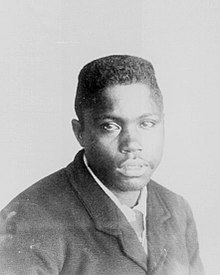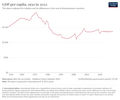
Back بوابة:مدغشقر Arabic Portal:Madagascar Spanish Portail:Madagascar French Portale:Madagascar Italian Portaal:Madagaskar Dutch Portal:Madagáscar Portuguese Портал:Мадагаскар Russian ද්වාරය:මැඩගස්කරය Singhalese باب:مڈغاسکر Urdu
The Madagascar Portal
Madagascar, officially the Republic of Madagascar, is an island country comprising the island of Madagascar and numerous smaller peripheral islands. Lying off the southeastern coast of Africa, it is the world's fourth largest island, the second-largest island country and the 46th largest country in the world. Its capital and largest city is Antananarivo. Following the prehistoric breakup of the supercontinent Gondwana, Madagascar split from Africa during the Early Jurassic, around 180 million years ago, and split from the Indian subcontinent around 90 million years ago, allowing native plants and animals to evolve in relative isolation; consequently, it is a biodiversity hotspot and one of the world's 17 megadiverse countries, with over 90% of wildlife being endemic. The island has a subtropical to tropical maritime climate. Madagascar was first settled during or before the mid-first millennium AD by Austronesian peoples, presumably arriving on outrigger canoes from present-day Indonesia. These were joined around the ninth century AD by Bantu migrants crossing the Mozambique Channel from East Africa. Other groups continued to settle on Madagascar over time, each one making lasting contributions to Malagasy cultural life. Consequently, there are 18 or more classified peoples of Madagascar, the most numerous being the Merina of the central highlands. Until the late 18th century, the island of Madagascar was ruled by a fragmented assortment of shifting sociopolitical alliances. Beginning in the early 19th century, most of it was united and ruled as the Kingdom of Madagascar by a series of Merina nobles. The monarchy was ended in 1897 by the annexation by France, from which Madagascar gained independence in 1960. The country has since undergone four major constitutional periods, termed republics, and has been governed as a constitutional democracy since 1992. Following a political crisis and military coup in 2009, Madagascar underwent a protracted transition towards its fourth and current republic, with constitutional governance being restored in January 2014. (Full article...) This is a Featured article, which represents some of the best content on English Wikipedia..
Philibert Rabezoza (1923 – 29 September 2001), better known by the name Rakoto Frah, was a flautist and composer of traditional music of the central highlands of Madagascar. Born in 1923 near the capital city of Antananarivo to a poor rural family, Rakoto Frah surmounted the challenges posed by his underprivileged origins to become the most acclaimed 20th century performer of the sodina flute, one of the oldest traditional instruments on the island. Through frequent international concerts and music festival performances, he promoted the music of the highlands of Madagascar and became one of the most famous Malagasy artists, both within Madagascar and on the world music scene. After gaining regional recognition for his sodina skills as a youth, Rakoto Frah rose to national fame in 1958 when he was selected by Malagasy President Philibert Tsiranana to perform on the sodina for the visiting French president Charles de Gaulle. This event launched his career as a professional musician. He first played at traditional ceremonies around the country, then expanded his performances from 1967 to include participation in international music competitions and festivals. His popularity declined in the 1970s but underwent a revival that began in the mid-1980s and continued until his death in 2001. During this period Rakoto Frah recorded ten albums, toured extensively in Madagascar and overseas, was featured in two French documentaries, and collaborated with a variety of international and Malagasy artists. Over the course of his career he recorded over 800 original compositions. Rakoto Frah and his sodina were depicted on the 200 ariary Malagasy banknote in honor of his key role in revitalizing and internationally popularizing the sodina. Despite the artist's worldwide acclaim, he lived simply and died having earned little from his lifetime of musicianship. His death was widely mourned and marked by a state funeral, and in 2011 a famadihana (the Malagasy highland "turning of the bones" funerary tradition) was organized to celebrate the artist's life. (Full article...)Selected article - The Hova, or free commoners, were one of the three principal historical castes in the Merina Kingdom of Madagascar, alongside the Andriana (nobles) and Andevo (slaves). The term hova originally applied to all members of a Malagasy clan (possibly of the Zafiraminia people) that migrated into the central highlands from the southeast coast of the island around the 15th century and absorbed the existing population of Vazimba. Andriamanelo (1540–1575) consolidated the power of the Hova when he united many of the Hova chiefdoms around Antananarivo under his rule. The term Hova remained in use through the 20th century, though some foreigners transliterated that word to be Ankova, and increasingly used since the 19th century. In and after the 16th century, slaves were brought into Madagascar's various kingdoms, and social strata emerged in Merina kingdom. The Hova emerged as the free commoners caste below the nobles hierarchy. The subset of Hova related to the king by blood came under the title Andriana. The social structure of the new kingdom became further defined under his son Ralambo (1575–1612), who further subdivided the Andriana into four ranks. Ralambo was also the first to use the term Imerina (land of the Merina) to describe the land occupied by the Hova people, who thereafter gradually adopted the identity and label of Merina. (Full article...)This is a Good article, an article that meets a core set of high editorial standards.
Petter's tufted-tailed rat (Eliurus petteri) is a rodent in the genus Eliurus found in lowland eastern Madagascar. First described in 1994, it is most closely related to the smaller Eliurus grandidieri. Virtually nothing is known of its natural history, except that it occurs in rainforest and is nocturnal and solitary. It is threatened by destruction and fragmentation of its habitat and is listed as "Vulnerable" on the IUCN Red List. With a head and body length of 130 to 136 mm (5.1 to 5.4 in), Eliurus petteri is a moderately large species of Eliurus. Its upperparts are gray-brown to gray and contrast sharply with the white underparts. The tail tuft, a characteristic feature of Eliurus, is weakly developed. The skull is delicate and the incisive foramina (openings in the front part of the palate) are short and narrow. The incisors are weak. (Full article...)General images -The following are images from various Madagascar-related articles on Wikipedia.
Selected panoramaLandscape near Fianarantsoa, Madagascar.
TopicsCategoriesSelected pictureAssociated WikimediaThe following Wikimedia Foundation sister projects provide more on this subject:
Discover Wikipedia using portals | |||










































































